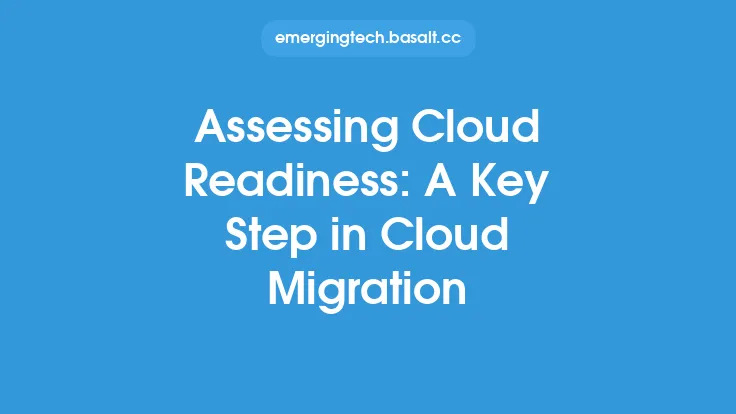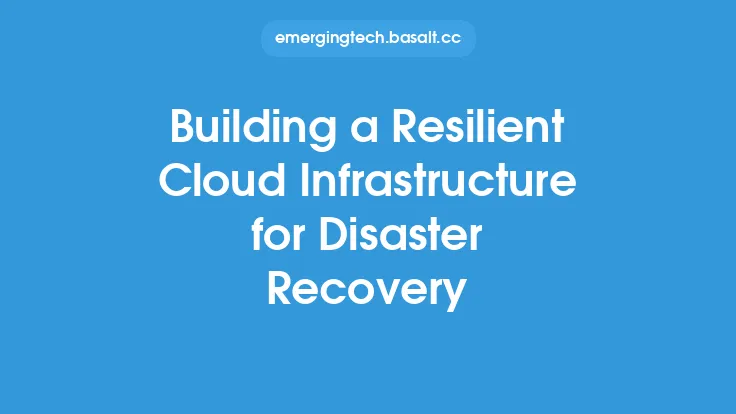Cloud infrastructure is the backbone of cloud computing, providing the necessary hardware and software components to support the delivery of cloud services. At its core, cloud infrastructure consists of a complex network of physical and virtual resources that work together to provide scalable, on-demand access to computing resources. The key components of cloud infrastructure can be broadly categorized into several layers, each playing a critical role in the overall functionality of the cloud.
Introduction to Cloud Infrastructure Components
The components of cloud infrastructure can be divided into two main categories: physical components and virtual components. Physical components include the hardware and networking equipment that make up the cloud infrastructure, such as servers, storage systems, and network devices. Virtual components, on the other hand, include the software and virtualization layers that enable the creation of virtual resources, such as virtual machines, virtual networks, and virtual storage.
Compute Resources
Compute resources are the backbone of cloud infrastructure, providing the processing power and memory required to run applications and services. Compute resources can be further divided into several sub-components, including:
- Servers: These are the physical machines that provide the processing power and memory for the cloud. Servers can be bare-metal or virtualized, and can be configured to provide a range of computing resources, from small-scale web servers to large-scale enterprise applications.
- Virtual Machines (VMs): VMs are software emulations of physical servers, providing a layer of abstraction between the physical hardware and the operating system. VMs can be created and configured to provide a range of computing resources, from small-scale development environments to large-scale production environments.
- Containers: Containers are lightweight and portable, providing a isolated environment for applications to run in. Containers are often used in conjunction with VMs, providing an additional layer of abstraction and isolation.
Storage Resources
Storage resources are a critical component of cloud infrastructure, providing the necessary storage capacity and performance to support applications and services. Storage resources can be further divided into several sub-components, including:
- Block Storage: Block storage provides raw storage capacity, allowing users to create and manage their own file systems and storage volumes. Block storage is often used for applications that require high-performance storage, such as databases and virtual machines.
- File Storage: File storage provides a shared file system, allowing users to store and retrieve files in a hierarchical directory structure. File storage is often used for applications that require shared access to files, such as web servers and collaboration platforms.
- Object Storage: Object storage provides a scalable and durable storage solution, allowing users to store and retrieve large amounts of unstructured data, such as images, videos, and documents. Object storage is often used for applications that require high-capacity storage, such as data lakes and content delivery networks.
Network Resources
Network resources are a critical component of cloud infrastructure, providing the necessary connectivity and bandwidth to support applications and services. Network resources can be further divided into several sub-components, including:
- Physical Networks: Physical networks provide the underlying connectivity for the cloud, including routers, switches, and firewalls. Physical networks can be configured to provide a range of networking protocols and services, from simple IP connectivity to complex VPNs and MPLS networks.
- Virtual Networks: Virtual networks provide a software-based emulation of physical networks, allowing users to create and manage their own virtual networks and subnets. Virtual networks are often used in conjunction with VMs and containers, providing an additional layer of isolation and security.
- Load Balancers: Load balancers provide a critical component of cloud infrastructure, allowing users to distribute traffic across multiple servers and applications. Load balancers can be configured to provide a range of load balancing algorithms and protocols, from simple round-robin to complex content-based routing.
Security Components
Security components are a critical component of cloud infrastructure, providing the necessary protection and isolation to support applications and services. Security components can be further divided into several sub-components, including:
- Firewalls: Firewalls provide a critical component of cloud security, allowing users to control and filter traffic flowing into and out of the cloud. Firewalls can be configured to provide a range of security protocols and services, from simple packet filtering to complex intrusion detection and prevention.
- Access Control: Access control provides a critical component of cloud security, allowing users to control and manage access to cloud resources and applications. Access control can be configured to provide a range of authentication and authorization protocols, from simple username and password to complex multi-factor authentication.
- Encryption: Encryption provides a critical component of cloud security, allowing users to protect and secure data in transit and at rest. Encryption can be configured to provide a range of encryption protocols and services, from simple SSL/TLS to complex full-disk encryption.
Management and Monitoring Components
Management and monitoring components are a critical component of cloud infrastructure, providing the necessary tools and services to support the deployment, management, and monitoring of cloud resources and applications. Management and monitoring components can be further divided into several sub-components, including:
- Cloud Management Platforms: Cloud management platforms provide a comprehensive set of tools and services for managing and monitoring cloud resources and applications. Cloud management platforms can be configured to provide a range of management and monitoring protocols and services, from simple resource provisioning to complex application performance monitoring.
- Monitoring and Logging: Monitoring and logging provide a critical component of cloud management, allowing users to monitor and log cloud resources and applications. Monitoring and logging can be configured to provide a range of monitoring and logging protocols and services, from simple system logging to complex application performance monitoring.
- Automation and Orchestration: Automation and orchestration provide a critical component of cloud management, allowing users to automate and orchestrate cloud resources and applications. Automation and orchestration can be configured to provide a range of automation and orchestration protocols and services, from simple script-based automation to complex workflow-based orchestration.
Conclusion
In conclusion, the key components of cloud infrastructure provide the necessary hardware and software components to support the delivery of cloud services. From compute resources to storage resources, network resources to security components, and management and monitoring components, each component plays a critical role in the overall functionality of the cloud. By understanding the key components of cloud infrastructure, users can better design, deploy, and manage their cloud resources and applications, taking advantage of the scalability, flexibility, and cost-effectiveness of the cloud.





